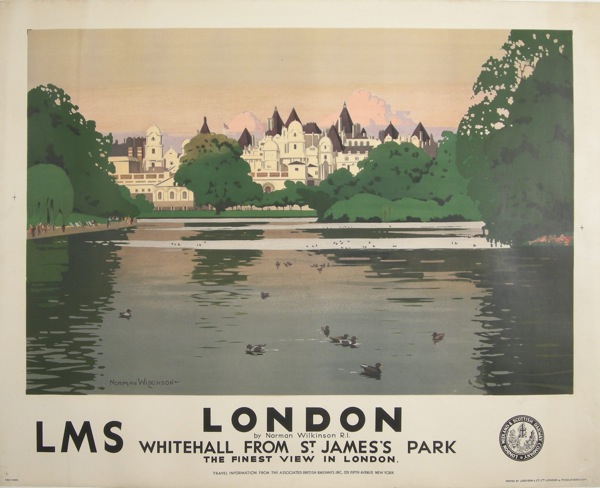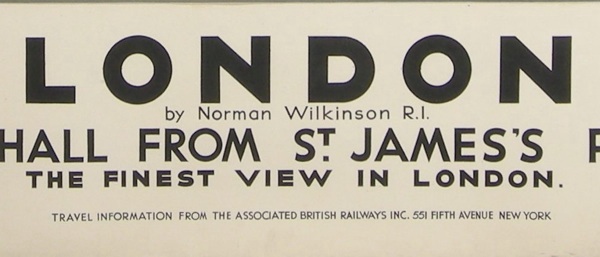Today on Quad Royal, a reader’s question. And it’s not one I can answer, so I thought I’d throw it open to you lot.
Take a look at this.
A classic. A Norman Wilkinson classic from 1930 to be precise. But now take a look at the small print.
Travel information from the Associated British Railways Inc, New York.
Now a bit of research tells me that this was a body formed by all the British Railway companies in the early 1930s whose job was to promote rail tourism in the UK to Americans, and which lasted until the Second World War. Their imprint appears on other posters – and in fact we bought one from the states with their name and address pasted over the original LNER text on a thin strip of paper.
But none of this answers the question I was asked. Which is, does this make any difference to the value of the poster? Is it a rarity, or do the usual considerations of artist, image, condition still count for more? I don’t know, so I said I’d put the question out to you lot. What do you think?


You need to distinguish between the value in an aesthetic and social sense and the price of the object. There could be collectors who want to have a copy of every edition and variation of this particular print in order to own a full set of them . Such a person could be expected to pay a far higher price for this poster than the other variants simply by virtue of its rarity. The stamp market provides a lot of examples of this kind of pricing with misprints, for example, which would have been regarded as worthless when made, attracting an above average price because they are uncommon. Whether the same will happen to posters who knows? It’s very much to be hoped, however, that the true devotees of the medium will continue to attach more importance to value than price – in which case, of course, the addition of a few words to this Wilkinson can be ignored as unimportant. Unless you want to argue that the extra words alter the composition or make it a less authentic Wilkinson design than the original version which would start a discussion that would probably never end.
I hope this isn’t just about someone trying to find out whether something is worth buying…
That’s not a spirit worth encouraging.
Fair points by Stockwell, although the stamp market is very much more highly developed than that of posters. The catalogue of availability and prices by Stanley Gibbons is a crucial part of that market and doesn’t really exist yet in posters. The weird world of stamps can be glimpsed in Simon Garfield’s “Error World.”
I’ve had quite a few posters with bits of text pasted over them. I don’t think this makes any difference to price or value. The poster market isn’t that sophisticated yet and there aren’t enough posters out there to make this kinds of distinction necessary. Condition is more important for most collectors, who will just want to put it on the wall.
I’m intrigued by the fact that this Wilkinson seems to imply a separate edition for the US. Not just over-pasting some additional text. At what point was it worth printing another edition – 50 copies, 500 or 1500? That insight will give some background to pricing. Researching that side of things will make the poster more interesting as a specific example of a marketing strategy in the US… over to DCH Watts.
With posters of this type where the text is not an integral part of the design I don’t think variations have much influence upon price.
There is one example where I thought it might, but this was not borne out by the Morphets sale last year. I’m thinking of the Charles Mayo GWR quad royal entitled boldly, ‘Speed to the West’. The version for the US market was retitled, ‘Cornish Riviera Express’. I thought the named train may have given it some sort of cachet but the single example in the Malcolm Guest collection achieved a lower price than most of the numerous Speed to the West copies! May be the Speed to the West slogan is desirable enough in itself. Or perhaps the greyed-out GWR logos in the US version diminished its appeal.
Thank you everyone for your thoughts. I’m inclined to agree that this kind of oddity doesn’t make much difference to the price of the poster, which will depend much more on the image and condition. It might make it slightly more attractive to an American collector, perhaps, but that would be about it.
And Paul – I also agree, it’s the marketing strategy behind it which makes it intriguing. I’d also be fascinated to know which posters were chosen for these campaigns too – it would be quite revealing about images and preconceptions of Britain at the time.
MM – that’s also really interesting, as it takes the marketing up a notch too. Although when you look at the Morphets results, the condition may have made a difference to the prices too. Not that I have any idea about the value of train posters and their logos, so you may well be right.